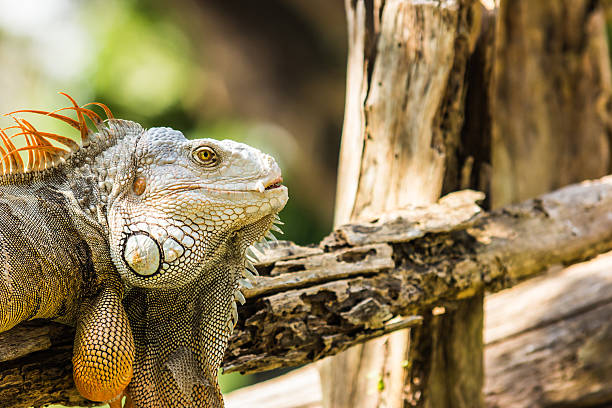Iguanas are fascinating creatures known for their unique behaviors, such as their head-bobbing movements. Head-bobbing is a common behavior in many species of iguanas and is often used for communication. Understanding why iguanas nod their heads is important for pet owners and researchers, as it can provide insight into their behavior, needs, and overall well-being. In this article, we will explore the reasons behind this behavior and the different variations seen in different species of iguanas. People often wonder why do iguanas nod their heads as a form of communication.

Importance Of Understanding Iguana Behavior
Understanding iguana behavior is crucial for several reasons. For pet owners, knowing why their iguana is exhibiting certain behaviors can help them provide the appropriate care and create a suitable environment for their pet. This can also prevent potential health problems and ensure that the iguana is living a happy and healthy life. Explore the fascinating world of iguanas and their behaviors at studyiguana.com.
Additionally, understanding iguana behavior is important for researchers and conservationists, as it can provide insights into their ecology, biology, and evolutionary history. This knowledge can help develop effective conservation strategies to protect the species and their habitats. Understanding why do iguanas nod their heads can enhance our knowledge of their social behaviors.

Anatomy of Iguanas
Iguanas are reptiles that belong to the family Iguanidae. They are known for their distinctive physical characteristics, including their long tails, sharp claws, and spiny crests along their backs. Iguanas also have a unique head and neck structure that enables them to move their heads and necks in various directions, including the famous head-bobbing movement.
Their skulls are fused, immovable, and elongated, giving them a unique appearance. Their necks are long and muscular, and they have a range of motion that allows them to look around their environment with ease. These physical features enable iguanas to survive and thrive in their natural habitats and help them communicate and interact with other iguanas. Many enthusiasts are curious about why do iguanas nod their heads during interactions.
Description Of The Physical Characteristics Of Iguanas
Iguanas have long, muscular tails, sharp claws, and spiny crests along their backs. They have fused skulls and elongated necks, enabling them to move their heads and necks in various directions. Pet owners often ask, “Why do iguanas nod their heads?” to better care for their reptiles.
Focus On The Structure Of Their Heads And Necks
The unique structure of iguanas’ heads and necks enables them to move their heads and necks in various directions, including the famous head-bobbing movement, and to communicate and interact with other iguanas.
Head-Bobbing Behavior
Scientists are investigating why do iguanas nod their heads to learn more about their communication methods. Head-bobbing is a common behavior in many species of iguanas, used for communication with other iguanas and to signal their mood, intentions, and responses to environmental stimuli.
Description of Head-Bobbing Behavior In Iguanas
Iguanas nod their heads up and down or side to side, at different speeds and intensities, depending on the situation and their intentions, such as territorial displays, mating behavior, aggression, submission, or relaxation.
How Iguanas Communicate Through Head-Bobbing
Head-bobbing is a form of visual communication in iguanas. It is used to communicate various messages, including territorial displays, mating behavior, aggression, submission, or relaxation. For example, male iguanas may bob their heads to show off their dominance and establish territory boundaries, while female iguanas may bob their heads to signal their receptiveness to mating.
The frequency, duration, and intensity of head-bobbing can convey different meanings and intentions, and iguanas can also use other forms of body language, such as tail flicking, posture, and color changes, to complement their head-bobbing behavior. Overall, head-bobbing is a crucial way for iguanas to communicate and interact with each other, and understanding this behavior can provide valuable insights into their social dynamics and behavior.
Video or Image of Iguanas Head-Bobbing
A video or image of iguanas head-bobbing can be a fascinating and educational way to observe their behavior and communication. It can show the different variations of head-bobbing, such as the speed, intensity, and direction of the movements, and the accompanying body language.
It can also showcase the different situations and contexts in which iguanas head-bob, such as during territorial disputes, courtship rituals, or relaxation. Videos or images can be useful tools for researchers, educators, and pet owners to understand and appreciate the behavior of iguanas. However, it’s important to remember that iguanas are living creatures and should be treated with respect and care, and not exploited for entertainment purposes.
Reasons for Head-Bobbing Behavior
Head-bobbing is a common behavior in iguanas used for various reasons, including territorial displays, mating behavior, aggression, and submission. Male iguanas use head-bobbing to show dominance during territorial disputes and attract females during mating season. Female iguanas may also head-bob to signal their reproductive readiness. Overall, head-bobbing is an important form of communication and behavior in iguanas. It’s fascinating to explore why do iguanas nod their heads, as it reveals their unique ways of expressing themselves.
Territorial Displays
Iguanas use territorial displays to establish dominance and boundaries. Head-bobbing is a common behavior during these displays, with the more dominant iguana head-bobbing more frequently and vigorously. Animal behaviorists often study why do iguanas nod their heads to understand their social dynamics.
Mating Behavior
Mating behavior in iguanas involves head-bobbing displays to attract and court potential mates. Male iguanas head-bob to show off their dominance, while females may head-bob to signal their reproductive readiness.
Sign of Aggression or Submission
Head-bobbing can also be a sign of aggression or submission in iguanas. A threatened iguana may head-bob to show aggression, while a submissive iguana may head-bob as a sign of surrender.
Response to Environmental Stimuli
Iguanas may head-bob in response to environmental stimuli, such as changes in light or temperature. This behavior can help regulate their body temperature and signal to other iguanas in the area.
Sign of Relaxation
Iguanas may also head-bob as a sign of relaxation or contentment, especially when basking in the sun. This behavior can help regulate their body temperature and indicate a peaceful state.
Variations in head-bobbing behavior
While head-bobbing is a common behavior in iguanas, the frequency and intensity of the behavior can vary between individuals and situations. Some iguanas may head-bob more frequently and vigorously than others, depending on their social status or the context of the situation.
Differences in Head-Bobbing Behavior Between Species of Iguanas
Head-bobbing behavior can vary between different species of iguanas. For example, some species may use head-bobbing more frequently during territorial displays, while others may use it more during mating behavior. Understanding these differences can help researchers better understand the behavior and communication of different iguana species.
Differences in Head-Bobbing Behavior Between Genders And Age Groups
Head-bobbing behavior can also vary between genders and age groups within a species of iguana. Male iguanas may head-bob more frequently and intensely than females, especially during territorial displays and mating behavior. Juvenile iguanas may also head-bob differently than adult iguanas, as their behavior and social status are still developing.
Factors That Influence The Frequency And Intensity Of Head-Bobbing Behavior
Here’s an explanation of the factors that can influence the frequency and intensity of head-bobbing behavior in iguanas:
Social Status
Iguanas may head-bob more frequently and vigorously to establish dominance over other iguanas in their social group.
Environmental Factors
Changes in temperature, lighting, or other environmental factors can trigger head-bobbing behavior in iguanas as they regulate their body temperature and signal to other iguanas.
Reproductive Behavior
Head-bobbing is often used during mating displays and courtship rituals to signal reproductive readiness and attract potential mates.
Threat Displays
Iguanas may head-bob as a threat display to signal aggression towards other iguanas or potential predators.
Individual Variation
Some iguanas may naturally head-bob more frequently or intensely than others due to genetic or personality differences.
Understanding these factors can provide valuable insights into the behavior and communication of iguanas in different contexts and situations.
Conclusion
Head-bobbing is an important form of iguana communication. Studying it can deepen our understanding of their behavior. Head-bobbing can serve a variety of functions. Iguanas are fascinating creatures worth learning more about.
FAQS
What is head-bobbing behavior in iguanas?
Head-bobbing is a common behavior in which iguanas rhythmically bob their heads up and down.
Why do iguanas head-bob?
Iguanas head-bob for a variety of reasons, including territorial displays, mating behavior, threat displays, and relaxation.
Do all iguanas head-bob?
No, not all iguanas head-bob, but it is a common behavior in many species.
How can you tell if an iguana is happy or relaxed?
One sign of relaxation in iguanas is slow, deliberate head-bobbing with relaxed body language.
Can head-bobbing behavior vary between iguana species?
Yes, there can be differences in the frequency, intensity, and context of head-bobbing behavior between different species of iguanas.
Is head-bobbing behavior a sign of aggression?
Head-bobbing can be a sign of aggression or submission, depending on the context in which it occurs.
Can iguanas communicate with other forms of body language besides head-bobbing?
Yes, iguanas use a variety of body language, such as tail flicking and body posture, to communicate with one another.
Additional readings
